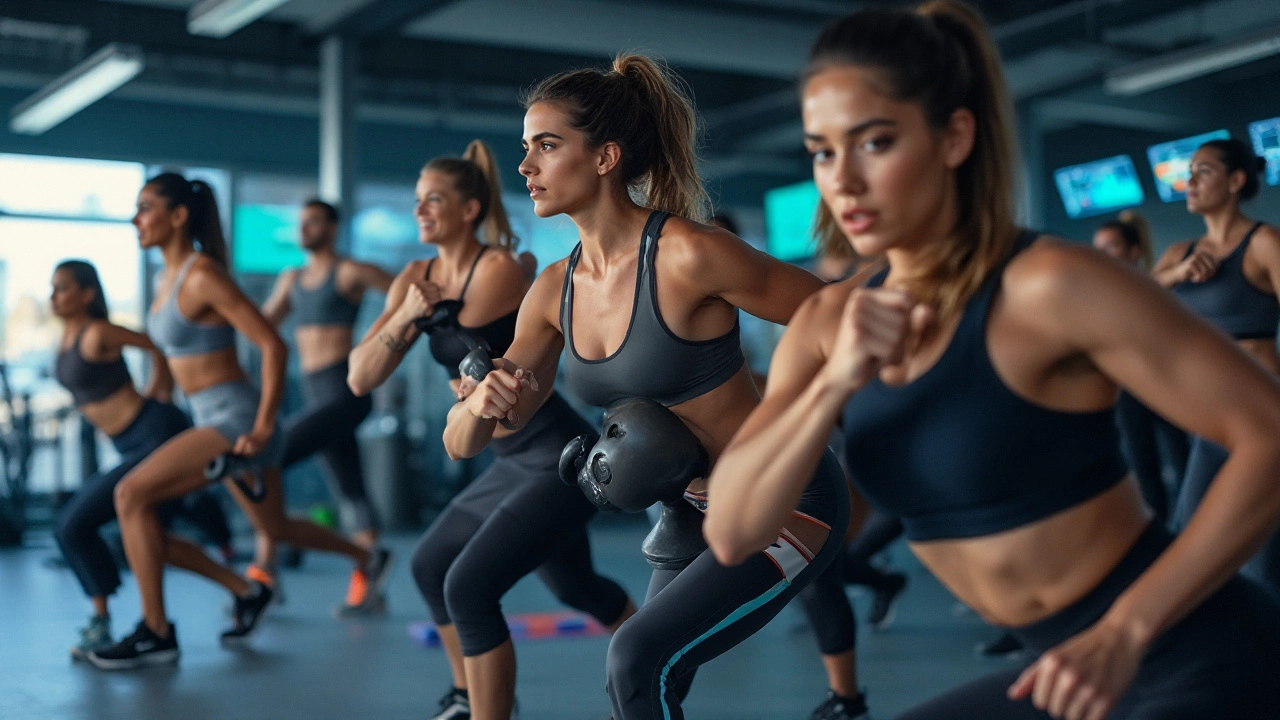
In the world of fitness, High-Intensity Interval Training, commonly known as HIIT, is often celebrated for its efficiency and effectiveness. But a common question emerges: does this form of exercise primarily build muscle or does it target fat burning? As you navigate through your fitness journey, understanding the distinct impacts of HIIT on muscle and fat can help align your workouts with your goals.
At its core, HIIT involves pushing your body to its limits in short but powerful bursts, followed by periods of rest or lower intensity. This approach not only ramps up your heart rate but creates a valuable workout environment for both muscle gain and fat loss. However, the outcomes depend on how the training is structured and individual body responses.
We'll explore the mechanics of HIIT, diving into what makes it such a versatile workout. By examining the science behind it, you can uncover strategies to harness HIIT’s potential, whether you're looking to get leaner, stronger, or both. Ready to decode the power of HIIT and unlock its benefits?
- Introduction to HIIT Workouts
- How HIIT Builds Muscle
- The Fat-Burning Mechanism of HIIT
- Balancing Muscle Gain and Fat Loss
- Tips for Maximizing HIIT Benefits
Introduction to HIIT Workouts
High-Intensity Interval Training, lovingly dubbed HIIT, is often the talk of the town in fitness circles and for good reason. Imagine a workout style that requires far less of your time while promising the same, if not better, results as traditional exercises. That's where HIIT steps in. It's a methodology that alternates between intense periods of exercise and short rest intervals. Forget about spending hours at the gym; here, it's all about exerting maximum effort in minimal time, and people are loving it. The appeal lies in its accessibility: HIIT can be adapted to suit abilities and fitness levels, from novice to experienced athlete, encompassing exercises that range from sprinting to circuit-based moves.
At its core, HIIT is based on one apparently simple principle: push yourself hard and then recover. This burst-and-rest cycle is highly efficient for fat burning and cardiovascular health. According to a study published in the Journal of Obesity, HIIT not only reduces fat but particularly targets visceral fat, the type that's linked to numerous health concerns. As HIIT gained traction, it expanded beyond the realm of just fat burning. The workouts, which often integrate bodyweight exercises, have distilled an important realization: it's not just a heart-raiser, it's a tool for serious muscle strength.
Did you ever wonder why elite athletes incorporate HIIT into their training regimens? It's because of its unrivaled effectiveness and time efficiency. Consider this quote from the American College of Sports Medicine, which says,
"HIIT has been found to improve aerobic and anaerobic fitness, blood pressure, cardiovascular health, insulin sensitivity, cholesterol profiles, and abdominal fat and body weight while maintaining muscle mass."Given the recognition by such bodies, it's no wonder HIIT has become a staple in workout routines. Whether you are running on a treadmill or killing it in a boxing class, HIIT lets you maximize calorie burn within shorter sessions.
But can everyone jump onto the HIIT bandwagon? The answer lies in personalization. A well-designed HIIT routine respects individual limits, starting with less intense variations before building up to the more demanding routines. Importantly, each session can be customized: whether focused on muscle building, shifting fat, or mixing both, the choice alone is empowering. Critical to HIIT’s success is the form and intensity, both daring us to redefine our thresholds and encouraging the merging of mental willpower with physical endurance. Indeed, in the tapestry of modern fitness, HIIT is not a mere trend. It's a revolutionary rethinking of how we can be our fittest selves.
How HIIT Builds Muscle
High-Intensity Interval Training (HIIT workouts) isn't just about torching calories—it's also a powerful ally in building muscle. At first glance, it might seem counterintuitive that such a high-speed, endurance-building routine can contribute to muscle growth, yet this is precisely where the magic lies. During a HIIT session, the alternation between explosive, high-energy bursts and brief recovery phases repeatedly pushes your muscles to their limits, sparking a range of physiological responses. These responses not only promote muscle strength but also enhance endurance and flexibility.
The secret to how muscle building occurs in HIIT lies in the concept of muscle hypertrophy. Hypertrophy is stimulated when muscles are subjected to increased resistance or stress, causing micro-tears in the muscle fibers. As your body repairs these micro-tears, muscles grow larger and stronger. In the intense periods of HIIT, muscles are subjected to substantial exertion—think of sprinting at maximum capacity or lifting a heavy weight. This inevitably encourages the repair process, leading to muscle growth over time. For anyone doubting the efficacy of HIIT in muscle development, exercise physiologist cited in recent journals have observed measurable increases in strength among regular HIIT practitioners.
Another fascinating aspect of HIIT is its influence on hormonal balance, crucial for muscle growth. The vigorous nature of HIIT stimulates the release of growth hormone and testosterone. These hormones play pivotal roles in muscle formation and regeneration. More surprisingly, studies suggest that these hormone levels can remain elevated for hours after a workout, thus aiding prolonged muscle repair and growth. For athletes or fitness enthusiasts aiming to expand their muscle mass, integrating a few sessions of HIIT workouts weekly could prove transformative. Dr. John Berardi, a co-founder of Precision Nutrition, notes, "HIIT enhances your muscle fibers’ ability to handle stress, which is a key factor in muscle growth."
Additionally, one cannot overlook the role of HIIT in enhancing mitochondrial density within muscle tissue. Mitochondria, the energy powerhouses of cells, become more efficient over the course of repeated HIIT sessions. This increase in density means your muscles can utilize oxygen more effectively, leading to improved muscular endurance and faster recovery times. As your muscles adapt to these intensified energy requirements, the potential for muscle growth marginally increases. For those looking for efficient and succinct workouts, quite unlike traditional weightlifting routines, HIIT provides a formidable option.
In conclusion, while HIIT is predominantly recognized for its cardio benefits, its muscle-building capabilities are increasingly garnering attention. To optimize muscle growth through HIIT workouts, it's vital to incorporate exercises that specifically target different muscle groups, ensuring a well-rounded routine. This muscle-targeted approach, coupled with consistent effort, will help maximize both the fat burning and muscle building spectrums of HIIT. As you push through the challenging phases of HIIT, remember, the balance of intensity and recovery is key to unveiling muscle gains. As such, providing your body with the right nutrition and adequate rest goes a long way in supporting muscle recovery and growth.

The Fat-Burning Mechanism of HIIT
The magic behind the fat-burning capabilities of HIIT workouts lies in a physiological phenomenon known as Excess Post-Exercise Oxygen Consumption (EPOC). After an intense session, your body requires more oxygen to return to its resting state. This process, sometimes referred to as the 'afterburn effect', can elevate your metabolic rate for hours, or even days post-workout, translating to increased calorie burning. This particular aspect makes HIIT exceptionally effective at torching fat, even while you are not exercising. The intense bursts of activity kickstart this metabolic boost by pushing you to your limits, forcing your body to continue consuming calories long after the workout has ended.
Moreover, the high-intensity nature of HIIT engages both aerobic and anaerobic systems, thus recruiting and utilizing various types of fuels including stored fat. This makes HIIT an outstanding option for those with time constraints but seeking efficient results. Interestingly, research has shown that even brief sessions, averaging around 20 minutes, can have equivalent or superior effects on fat loss compared to traditional endurance exercises lasting longer periods. Such efficiency is particularly appealing for individuals balancing busy schedules with fitness aspirations. HIIT's ability to challenge the body's energy systems so completely is why it's often positioned as a fantastic exercise strategy for quick fat loss.
While the science behind HIIT is robust, it's important to understand that diet and overall lifestyle significantly influence fat loss results. An individual’s diet plays a critical role, serving as the foundation upon which such workouts build. To maximize fat-burning, coupling HIIT with nutritional strategies that emphasize high protein and controlled carbohydrates proves beneficial. Additionally, it's crucial to consider consistency over the long-term to truly harness these benefits. Consistent sessions allow the body to adapt positively, enhancing both endurance and metabolic flexibility, ultimately leading to more efficient energy usage from fat stores. Patience and perseverance in HIIT regimes invariably yield desirable body composition changes, favoring fat loss without extreme measures.
"High-intensity interval training burns significantly more subcutaneous fat than regular cardio, making it excellent for improving body composition," notes Dr. Paolo Simeoni, a leading sports scientist.
To ensure these workouts achieve desired fat-burning results, it is beneficial to maintain variety and progression. Rotating different exercises and gradually increasing intensity or duration helps prevent plateaus. Regular adjustments stimulate continual adaptation, facilitating ongoing progress in fat utilization. Furthermore, adopting a balanced training routine that includes HIIT prevents overdependence on one modality, reducing risk of injury and burnout. By keeping things diverse and challenging, you sustain motivation and avoid the monotony that often derails long-term fitness ambitions. Embrace the flexibility that HIIT offers — it can be done nearly anywhere with limited equipment, adding convenience to your regimen.
| Benefits of HIIT for Fat Loss | Details |
|---|---|
| Time Efficiency | Burns more fat in short periods. |
| Afterburn Effect | Elevates metabolism for hours post-exercise. |
| Aerobic and Anaerobic Growth | Utilizes different fuel systems, enhancing fat use. |
Balancing Muscle Gain and Fat Loss
Many fitness enthusiasts face the dilemma of wanting to build muscle while simultaneously shedding unwanted fat. Achieving both these objectives might appear challenging, yet with a smart approach, it is certainly attainable. The secret lies in understanding how HIIT workouts can effectively balance these goals. Primarily, HIIT stimulates both muscle hypertrophy and fat loss by creating a high metabolic demand during its intense bursts of activity. This kind of training makes your body work extremely hard in a short span, leading to efficient fat burning even hours after you've finished exercising.
The increased intensity of HIIT not only enhances your cardiovascular fitness but also engages muscle fibers that are crucial for muscle growth. Moreover, since HIIT workouts often incorporate resistance or bodyweight exercises, they put an emphasis on muscle-building movements. You might find routines that include squat jumps, push-ups, or kettlebell swings, allowing you to target various muscle groups while keeping the heart rate sky-high. A consistent routine that integrates these elements can help you strike the perfect balance between toning up and dropping the kilograms.
Interestingly, how your diet complements your workout routine plays a substantial role as well. Consuming adequate protein, for instance, supports muscle recovery and growth while you burn fat. In fact, as a leading fitness expert once noted, “You can’t out-train a bad diet.”
A well-rounded approach that combines strategic HIIT workouts with a balanced nutritional plan tends to yield the best results.These nutritional needs, paired with an understanding of your body's caloric requirements, ensure you're optimizing muscle gain without compromising on fat loss. This balance is about keeping your body in a state of caloric deficit but ensuring enough nutrient intake to support your fitness goals.
Lastly, let’s not forget the role of recovery in this delicate balancing act. Allowing your muscles time to rest is pivotal. Some individuals focus non-stop on burning calories and forget that muscles grow during periods of rest and recovery. In fact, scheduling a mix of HIIT workouts with ample rest days can significantly affect how well you build muscle and burn fat over time. Integrating activities like yoga or stretching regimes on off-days keeps your body agile without overstressing it. Therefore, if you want to strike a harmonious balance, consider not only your workout sessions but your entire lifestyle to amplify your results.

Tips for Maximizing HIIT Benefits
Maximizing the benefits of HIIT workouts requires not just understanding the science behind them, but also knowing how to tailor the workouts to fit your unique fitness goals and body type. One key component is to ensure variety in your exercises. Switching up routines prevents your body from becoming accustomed to certain movements, which can stall progress. Incorporate different forms of activity such as sprinting, cycling, or bodyweight exercises to engage various muscle groups and keep the workouts fresh. Remember to pay attention to your rest intervals, as they are just as crucial as the workout intervals themselves. Listen to your body and adjust as needed; underestimating the importance of rest can lead to burnout or injury.
Understanding your personal balance between intensity and recovery is vital. Not every HIIT session needs to be at maximum exertion. Find a suitable rhythm where your body gets the challenge it needs without overtaxing it. Another essential aspect is incorporating strength training elements into your HIIT routines. These help in muscle building by using your body weight or light equipment that enhances resistance. A practical tip is to focus on compound movements like squats, lunges, and push-ups, which target multiple muscles at once, yielding greater fitness dividends. Adding a few sessions of weight training throughout your week can enhance the muscle-strengthening effect of HIIT.
Nutrition plays an integral role in achieving the dual objectives of muscle building and fat burning. Ensure that you're consuming enough protein to support muscle repair and growth. Lean meats, legumes, and dairy products can be excellent sources of protein. For energy, incorporate a balanced amount of carbohydrates and fats. Remember that your dietary choices should align with your workout goals; the right fuel energizes you to push harder during those intense intervals. Staying hydrated is non-negotiable. Dehydration can drastically impact your performance, so always keep a bottle of water handy to sip through your workout.
To keep track of your progress and identify areas of improvement, consider maintaining a workout journal. Logging your exercises, duration, intensity levels, and even how you felt during each session can provide valuable insights. Some people find that setting measurable goals, like increasing the duration of high-intensity intervals or reducing rest times, helps maintain motivation. With the technological advancements, fitness apps and wearables are great tools for offering data-driven insights and helping you stick to your fitness regime.
"HIIT not only helps in burning fat but strengthens the heart, improves VO2 max, and releases endorphins for a better mood," says Dr. Gunnar Peterson, a noted personal trainer and fitness expert.
Finally, engage in adequate stretching and warm-up routines before starting your HIIT workout. Not only do these practices prepare your muscles and joints for the intensity to come, but they also reduce the risk of injuries. A good warm-up session can range from 5 to 10 minutes, incorporating dynamic movements that mimic the exercises you will be performing. Likewise, cool down thoroughly after your session with static stretches to prevent stiffness and promote flexibility. These small habits can make a significant difference in optimizing your workout sessions.
